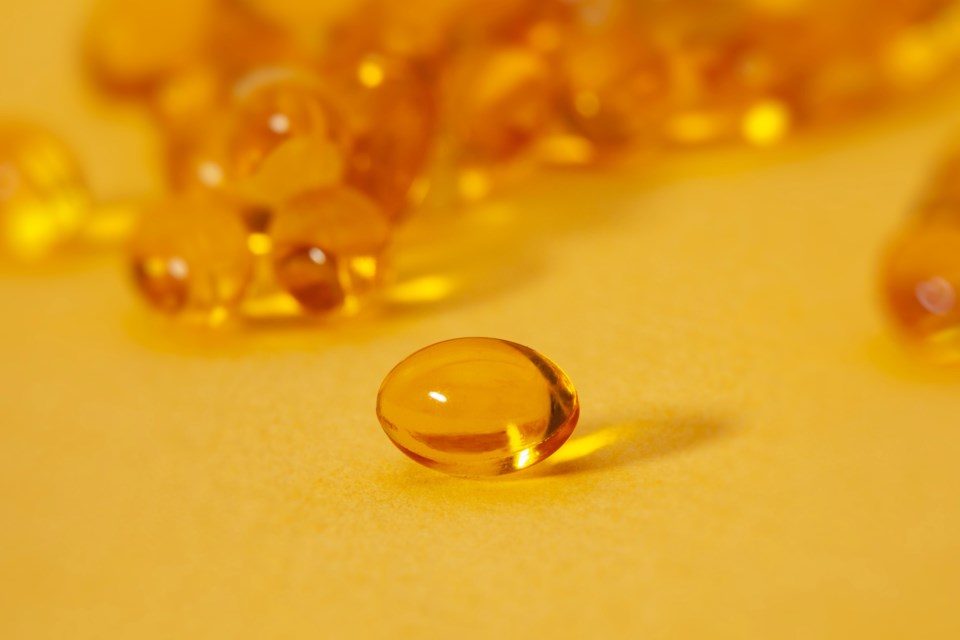As Canadians, we have long been told that because we get less sunlight in the fall and winter months we should take vitamin D supplements.
This compensates for the lack, guards against deficiency, and is advice that applies year-round.
But what is exactly is vitamin D and why do we need it? With help from the experts at the Harvard T.H. Chan School of Public Health, The Mayo Clinic and Health Canada, we find out.
What is vitamin D? What is vitamin D good for?
The answer is two-fold. It is both a nutrient we get from food and a hormone that is made by our bodies. It is needed for building and maintaining healthy bones and teeth, because the body can only absorb calcium when vitamin D is present.
It also regulates a number of cellular functions in the body. It has anti-inflammatory, antioxidant and neuroprotective properties that support immune health, muscle function, and brain cell activity.
This fat-soluble vitamin helps the body absorb and retain calcium and phosphorus, both of which are needed for your body to build bone. Without sufficient vitamin D, your bones are at risk of becoming soft, thin, and brittle. If you aren’t getting enough vitamin D from sunlight or food, you may need to take supplements.
Vitamin D has many benefits: it can reduce the growth of cancer cells, help control infections, and reduce inflammation. It turns out that several of our organs and tissues have receptors for vitamin D, suggesting its importance throughout the body—something scientists are currently investigating.

What are the sources of vitamin D?
Unfortunately there are few foods that naturally contain vitamin D. The best sources are the flesh of fatty fish, such as salmon, mackerel, arctic char, rainbow trout, swordfish, snapper, and sardines, as well as fish liver oils. Smaller amounts can be found in egg yolks, cheese, and beef liver. Some foods are fortified with it, such as orange juice, dairy products, plant milks, and cereals. Certain mushrooms also contain a small amount of vitamin D.
The sun, of course, is the greatest source of vitamin D. It is produced, in two forms, in the presence of the sun’s ultraviolet-B (UVB) rays: D2 is produced in plants and fungi, and D3 in animals, including humans. Our bodies make the vitamin when direct sunlight converts a chemical in our skin into an active form of vitamin D3.
That said, everyone absorbs vitamin D at different rates. A number of factors can come into play, including smog, season, time of day, cloud cover, sunscreen use, limited outdoor time, amount of skin exposed to sunlight, your age (we make less vitamin D as we get older), and the amount of melanin in our skin (it takes longer for people with more melanin in their skin to make vitamin D from the sun’s UV rays).
The best way to ensure you’re getting enough vitamin D is to take a daily supplement. These are available in two forms: vitamin D2 (also known as pre-vitamin D or ergocalciferol) and vitamin D3 (cholecalciferol).
For those of us who live in places where sunlight is limited in the winter, the usual production of vitamin D in the skin isn’t occurring. That means we’re lacking the primary natural source of this important vitamin. You might also have limited sun exposure because you are inside much of the time.

How much vitamin D do I need?
To maintain healthy bones and help the body metabolize calcium, there is a daily target that needs to be met. This number assumes minimal sun exposure.
The Recommended Dietary Allowance for adults aged 19 years and older is 600 IU, or 15 mcg, daily for men and women. For adults over 70 years of age it is 800 IU, or 20 mcg, daily.
It is not advised to take daily vitamin D supplements containing more than 4,000 IU unless you are under a doctor’s supervision.
Who is most at risk for vitamin D deficiency?
Many people may not be meeting the minimum daily requirement for the vitamin. In fact, worldwide it has been estimated that 1 billion people, of all and age groups, have inadequate levels of vitamin D in their blood.
In industrialized countries, doctors have even been seeing a resurgence of rickets—a bone-weakening disease that most assumed was a thing of the past.
You are at risk if you:
- Wear full-length clothing that covers the skin
- Spend limited time outdoors
- Have a darker skin tone
- Are a senior, as you are likely to spend more time indoors
- Live in a northern latitude above the equator where UVB light is weaker. Many Canadians can’t make enough vitamin D from the sun for 4-6 months of the year. The body actually stores vitamin D from sun exposure in the summer, but it is not enough to last the whole year through. By late winter, many who live in higher latitudes are deficient.

How do I know if I need vitamin D?
If your family doctor suspects you’re not getting enough vitamin D, it can be confirmed via a simple blood test.
You could be deficient for a number of reasons:
- A lack in the diet
- Poor absorption
- A metabolic need for higher amounts of the vitamin
Particular diets can play a role. If you can’t tolerate or don’t eat milk, eggs and fish—such as those with a lactose intolerance or who follow a vegan diet—you are at higher risk for a deficiency.
Other people at high risk of vitamin D deficiency include:
- People with inflammatory bowel disease (ulcerative colitis, Crohn’s disease) or other conditions that disrupt the normal digestion of fat.
- People who are obese. Vitamin D accumulates in excess fat tissues but is not easily available for use by the body when needed. You might need a higher dose of supplementation.
- People who have had gastric bypass surgery. This typically removes the upper part of the small intestine, where vitamin D is absorbed.
What conditions can result from a prolonged vitamin D deficiency?
- Rickets: This is when infants and children have soft bones and skeletal deformities caused when bone tissue doesn’t harden.
- Osteomalacia: With this condition, adults have weak and softened bones that can be reversed with supplementation.
What happens if your vitamin D is too high?
Don’t overdo it with the supplements. Taking too much vitamin D can also be harmful. Adults, pregnant and breastfeeding women, and children aged 9 or older who take more than 4,000 IU a day of vitamin D may experience:
- Poor appetite and weight loss
- Nausea and vomiting
- Constipation
- Weakness
- Confusion and disorientation
- Irregular heart beat
- Kidney stones and kidney damage
- Hardening of blood vessels and tissues due to increased blood levels of calcium, which can potentially lead to damage of the heart and kidneys
If you suspect you may have a vitamin D deficiency, the best course of action, as always, is to speak with your family doctor, as they will be able to confirm whether supplementation is necessary and can advise how much to take daily.




